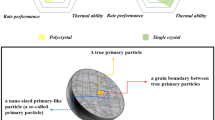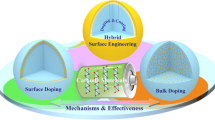Abstract
Development of high performance cathode materials, layer-structured ternary LiNixCoyM1−x−yO2 cathode materials have attracted much attention owing to their larger capacity and higher energy density. Persistent efforts have been devoted to tackling certain issues like low electronic conductivity and poor structural stability. Dual strategy of Mg doping and surface modification of the cathode material was adopted to improve the performance of the battery. Fullerene–Multi-Walled Carbon Nanotube (MWCNT) hybrid draped LiNi0.1Mg0.1Co0.8O2 nanocomposite was synthesized by a simple chemical route. The fullerene–MWCNT hybrid modifies the surface of pristine LiNi0.1Mg0.1Co0.8O2 thereby improves the electrochemical performance and maintains the structural stability of the cathode material. Pristine LiNi0.1Mg0.1Co0.8O2 and LiNi0.1Mg0.1Co0.8O2/fullerene–MWCNT nanocomposite were studied using various advanced characterization techniques such as X-ray diffraction (XRD), Micro-Raman spectroscopy, Field Emission Scanning Electron Microscopy (FESEM), X-ray Photoelectron Spectroscopy (XPS), and High-Resolution Transmission Electron Microscopy (HRTEM). It is found that LiNi0.1Mg0.1Co0.8O2 particles retain their structural integrity after being enveloped with a fullerene–MWCNT hybrid. The electrochemical performance was investigated with cyclic voltammetry (CV), galvanostatic charge–discharge (GCD) test and electrochemical impedance spectroscopy (EIS). As prepared LiNi0.1Mg0.1Co0.8O2, when deployed in the form of LiNi0.1Mg0.1Co0.8O2/fullerene–MWCNT composite exhibits a high specific capacity of 208 mAh g−1. Fullerene–MWCNT hybrid draped LiNi0.1Mg0.1Co0.8O2 nanocomposite provides an effective Li+ and electron channel that significantly increased the Li-ion diffusion coefficient and reduced the charge transfer resistance. Besides,the lithium diffusion coefficient increased from 5.13 × 10–13 (Li/LiNi0.1Mg0.1Co0.8O2) to 8.313 × 10–13 cm2 s−1 due to the improved kinetics of Li insertion/extraction process in Li/LiNi0.1Mg0.1Co0.8O2 + fullerene–MWCNT cell.










Similar content being viewed by others
Data Availability
Not applicable.
References
X. Meng, Recent progress of graphene as cathode materials in lithium ion batteries. IOP Conf. Ser. Earth Environ. Sci. 300, 042039 (2019). https://doi.org/10.1088/1755-1315/300/4/042039
D. Di Lecce et al., Multiwalled carbon nanotubes anode in lithium-ion battery with LiCoO2, Li[Ni1/3Co1/3 Mn1/3 ]O2, and LiFe1/4Mn1/2 Co1/4 PO4 cathodes. ACS Sustain. Chem. Eng. 6(3), 3225–3232 (2018). https://doi.org/10.1021/acssuschemeng.7b03395
S.S. Jan, S. Nurgul, X. Shi, H. Xia, H. Pang, Improvement of electrochemical performance of LiNi0.8Co0.1Mn0.1O2 cathode material by graphene nanosheets modification. Electrochim. Acta 149, 86–93 (2014). https://doi.org/10.1016/j.electacta.2014.10.093
A. Hakimian, S. Kamarthi, S. Erbis, K.M. Abraham, T.P. Cullinane, J.A. Isaacs, Economic analysis of CNT lithium-ion battery manufacturing. Environ. Sci. Nano 2(5), 463–476 (2015). https://doi.org/10.1039/C5EN00078E
X. Li et al., Improved rate capability of a LiNi1/3Co1/3Mn1/3O 2 /CNT/graphene hybrid material for Li-ion batteries. RSC Adv. 7(39), 24359–24367 (2017). https://doi.org/10.1039/C7RA03438E
W. Koh, J.I. Choi, S.G. Lee, W.R. Lee, S.S. Jang, First-principles study of Li adsorption in a carbon nanotube-fullerene hybrid system. Carbon N. Y. 49(1), 286–293 (2011). https://doi.org/10.1016/j.carbon.2010.09.022
K.-C. Jiang, S. Xin, J.-S. Lee, J. Kim, X.-L. Xiao, Y.-G. Guo, Improved kinetics of LiNi1/3Mn1/3Co1/3O2 cathode material through reduced graphene oxide networks. Phys. Chem. Chem. Phys. 14(8), 2934 (2012). https://doi.org/10.1039/c2cp23363k
R. Pongilat, K. Nallathamby, A novel Li2Mn2.9Ni 0.9Co0.2O8 spinel composite interweaved with carbon nanotube architecture as a lithium battery cathode. RSC Adv. 6(54), 49198–49205 (2016). https://doi.org/10.1039/C6RA04344E
T. Fujigaya, Development of thermoelectric conversion materials using carbon nanotube sheets. Bull. Chem. Soc. Jpn. 92(2), 400–408 (2019). https://doi.org/10.1246/bcsj.20180272
D.G. Papageorgiou, Z. Li, M. Liu, I.A. Kinloch, R.J. Young, Mechanisms of mechanical reinforcement by graphene and carbon nanotubes in polymer nanocomposites. Nanoscale 12(4), 2228–2267 (2020). https://doi.org/10.1039/C9NR06952F
M.M. Mohideen, Y. Liu, S. Ramakrishna, Recent progress of carbon dots and carbon nanotubes applied in oxygen reduction reaction of fuel cell for transportation. Appl. Energy 257, 114027 (2020). https://doi.org/10.1016/j.apenergy.2019.114027
S. Samad et al., Carbon and non-carbon support materials for platinum-based catalysts in fuel cells. Int. J. Hydrog. Energy 43(16), 7823–7854 (2018). https://doi.org/10.1016/j.ijhydene.2018.02.154
S. Sharma, B.G. Pollet, Support materials for PEMFC and DMFC electrocatalysts—a review. J. Power Sources 208, 96–119 (2012). https://doi.org/10.1016/j.jpowsour.2012.02.011
H. Zhang et al., Recent progress in advanced electrode materials, separators and electrolytes for lithium batteries. J. Mater. Chem. A 6(42), 20564–20620 (2018). https://doi.org/10.1039/C8TA05336G
Y. Ma, P. Cui, D. Zhan, B. Gan, Y. Ma, Y. Liang, Enhancement of the electrochemical performance of LiNi1/3Co1/3 Mn1/3O2 cathode material by double-layer coating with graphene oxide and SnO2 for lithium-ion batteries. J. Nanomater. 2019, 1–10 (2019). https://doi.org/10.1155/2019/7586790
H. Zhang, Synthesis and characterization of LiNi0.7-xMgxCo0.3O2 (0≤x ≤ 0.1) cathode materials for lithium- ion batteries prepared by a sol gel method. Adv. Mater. Sci. Eng. 2014, 1–7 (2014). https://doi.org/10.1155/2014/746341
J. Xiang, C. Chang, F. Zhang, J. Sun, Rheological phase synthesis and electrochemical properties of Mg-doped LiNi0.8Co0.2O2 cathode materials for lithium-ion battery. J. Electrochem. Soc. 155(7), A520 (2008). https://doi.org/10.1149/1.2917213
J. Cho, B. Park, Preparation and electrochemical/thermal properties of LiNi0.74Co0.26O2 cathode material. J. Power Sources 92(1–2), 35–39 (2001). https://doi.org/10.1016/S0378-7753(00)00499-7
R. Robert, C. Villevieille, P. Novák, Enhancement of the high potential specific charge in layered electrode materials for lithium-ion batteries. J. Mater. Chem. A 2(23), 8589 (2014). https://doi.org/10.1039/c3ta12643a
K. Yin, W. Fang, B. Zhong, X. Guo, Y. Tang, X. Nie, The effects of precipitant agent on structure and performance of LiNi1/3Co1/3Mn1/3O2 cathode material via a carbonate co-precipitation method. Electrochim. Acta 85, 99–103 (2012). https://doi.org/10.1016/j.electacta.2012.06.064
J. Wang, R. Ran, M.O. Tade, Z. Shao, Self-assembled mesoporous TiO2/carbon nanotube composite with a three-dimensional conducting nanonetwork as a high-rate anode material for lithium-ion battery. J. Power Sources 254, 18–28 (2014). https://doi.org/10.1016/j.jpowsour.2013.12.090
Y. Gong, M. Zhou, L. Andrews, Spectroscopic and theoretical studies of transition metal oxides and dioxygen complexes. Chem. Rev. 109(12), 6765–6808 (2009). https://doi.org/10.1021/cr900185x
C. Julien, Electrochemical performances of layered LiM1−yMy′O2 (M=Ni, Co; M′=Mg, Al, B) oxides in lithium batteries. Solid State Ion. 135(1–4), 121–130 (2000). https://doi.org/10.1016/S0167-2738(00)00290-3
P. Kalyani, N. Kalaiselvi, Various aspects of LiNiO2 chemistry: a review. Sci. Technol. Adv. Mater. 6(6), 689–703 (2005). https://doi.org/10.1016/j.stam.2005.06.001
N.H. Metwally, G.R. Saad, E.A. Abd El-Wahab, Grafting of multiwalled carbon nanotubes with pyrazole derivatives: characterization, antimicrobial activity and molecular docking study. Int. J. Nanomed. 14, 6645–6659 (2019). https://doi.org/10.2147/IJN.S182699
Z. Fang et al., Facile scalable synthesis of Co3O4/carbon nanotube hybrids as superior anode materials for lithium-ion batteries. Mater. Res. Bull. 48(10), 4419–4423 (2013). https://doi.org/10.1016/j.materresbull.2013.06.044
T. Drezen, N.-H. Kwon, P. Bowen, I. Teerlinck, M. Isono, I. Exnar, Effect of particle size on LiMnPO4 cathodes. J. Power Sources 174(2), 949–953 (2007). https://doi.org/10.1016/j.jpowsour.2007.06.203
M. Inaba, Y. Iriyama, Z. Ogumi, Y. Todzuka, A. Tasaka, Raman study of layered rock-salt LiCoO2 and its electrochemical lithium deintercalation. J. Raman Spectrosc. 28(8), 613–617 (1997). https://doi.org/10.1002/(SICI)1097-4555(199708)28:8%3c613::AID-JRS138%3e3.0.CO;2-T
A. Hasanzadeh, A. Khataee, M. Zarei, Y. Zhang, Two-electron oxygen reduction on fullerene C60-carbon nanotubes covalent hybrid as a metal-free electrocatalyst. Sci. Rep. 9(1), 13780 (2019). https://doi.org/10.1038/s41598-019-50155-7
A.C. Ferrari, J. Robertson, Raman spectroscopy of amorphous, nanostructured, diamond–like carbon, and nanodiamond. Philos. Trans. R. Soc. Lond. Ser. A Math. Phys. Eng. Sci. 362(1824), 2477–2512 (2004). https://doi.org/10.1098/rsta.2004.1452
X. Tang et al., Graphene wrapped ordered LiNi0.5Mn1.5O4 nanorods as promising cathode material for lithium-ion batteries. Sci. Rep. 5(1), 11958 (2015). https://doi.org/10.1038/srep11958
X. Tian, Y. Zhu, Z. Tang, P. Xie, A. Natarajan, Y. Zhou, Ni-rich LiNi0.6Co0.2Mn0.2O2 nanoparticles enwrapped by a 3D graphene aerogel network as a high-performance cathode material for Li-ion batteries. Ceram. Int. 45(17), 22233–22240 (2019). https://doi.org/10.1016/j.ceramint.2019.07.247
H.-M. Cho, M.V. Chen, A.C. MacRae, Y.S. Meng, Effect of surface modification on nano-structured LiNi0.5Mn1.5O 4 spinel materials. ACS Appl. Mater. Interfaces 7(30), 16231–16239 (2015). https://doi.org/10.1021/acsami.5b01392
A. Kumar et al., Mg doped Li2FeSiO4 /C nanocomposites synthesized by the solvothermal method for lithium ion batteries. Dalton Trans. 46(38), 12908–12915 (2017). https://doi.org/10.1039/C7DT03177G
L. Qu et al., Mg-doped Li2FeSiO4/C as high-performance cathode material for lithium-ion battery. J. Power Sources 307, 69–76 (2016). https://doi.org/10.1016/j.jpowsour.2015.12.137
Funding
Not applicable.
Author information
Authors and Affiliations
Corresponding author
Ethics declarations
Conflict of interest
The authors declare that they have no known competing financial interests or personal relationships that could have appeared to influence the work reported in this research paper.
Additional information
Publisher's Note
Springer Nature remains neutral with regard to jurisdictional claims in published maps and institutional affiliations.
Rights and permissions
About this article
Cite this article
Paniyarasi, S.A.S., Suja, S.K. & Elizabeth, R.N. Doping and Surface Modification Enhance the Applicability of Nanostructured Fullerene–MWCNT Hybrid Draped LiNi0.1Mg0.1Co0.8O2 as High Efficient Cathode Material for Lithium-Ion Batteries. J Inorg Organomet Polym 31, 3976–3990 (2021). https://doi.org/10.1007/s10904-021-02039-5
Received:
Accepted:
Published:
Issue Date:
DOI: https://doi.org/10.1007/s10904-021-02039-5




